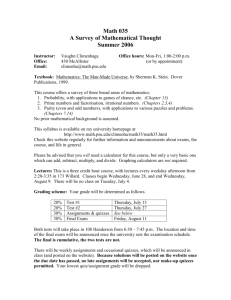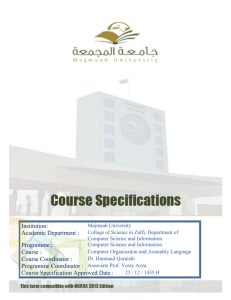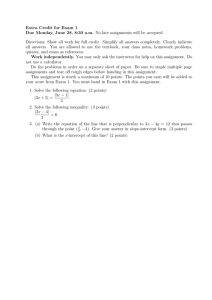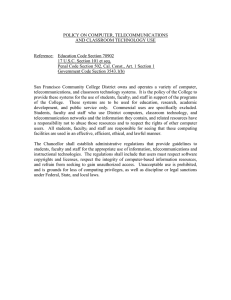تـوصـيـف مـقـرر نـظـم الـمعـلـومـات
advertisement
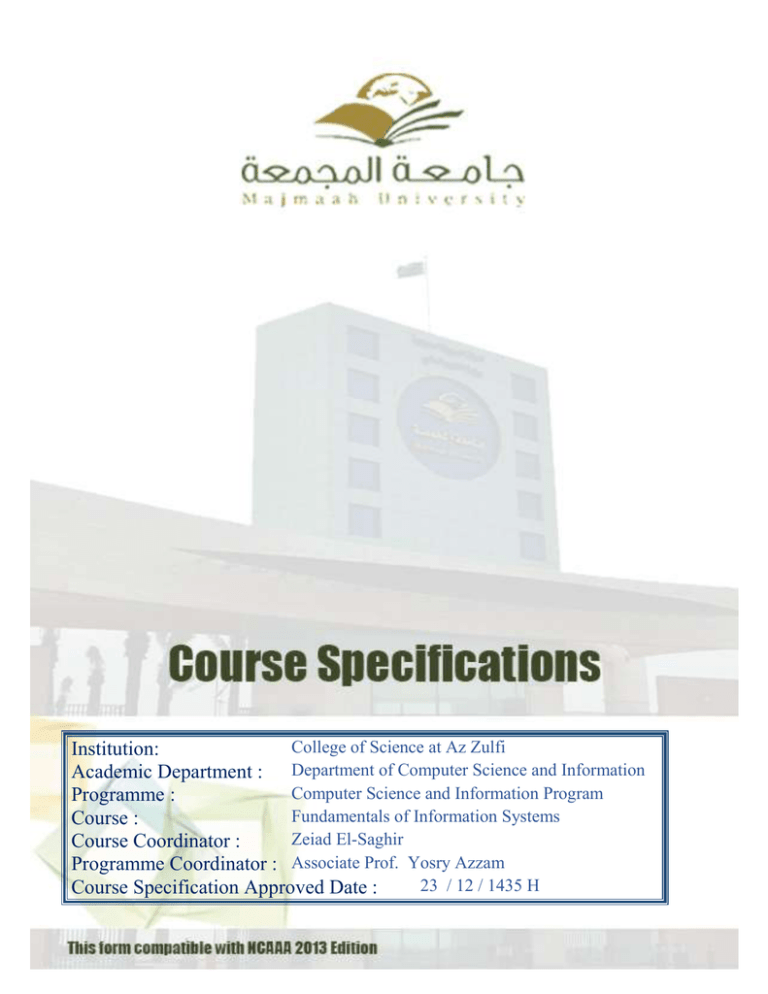
College of Science at Az Zulfi Institution: Academic Department : Department of Computer Science and Information Computer Science and Information Program Programme : Fundamentals of Information Systems Course : Zeiad El-Saghir Course Coordinator : Programme Coordinator : Associate Prof. Yosry Azzam 23 / 12 / 1435 H Course Specification Approved Date : A. Course Identification and General Information 1. 1 - Course title : Fundamentals of Course Code: CSI 224 Information Systems ( 3 Credit Hours ) (3 Lecture) 2. Credit hours : 3 - Program(s) in which the course is offered: Computer Science & Information 4 – Course Language : English 2. 5 - Name of faculty member responsible for the course: Dr. Zeiad El-Saghir 3. 6 - Level/year at which this course is offered : 4th Level 7 - Pre-requisites for this course (if any) : N/A 8 - Co-requisites for this course (if any) : N/A 9 - Location if not on main campus : ( College of Science at Az Zulfi ) 10 - Mode of Instruction (mark all that apply) A - Traditional classroom B - Blended (traditional and online) D - e-learning E - Correspondence F - Other √ What percentage? 80 % √ What percentage? 10 % What percentage? …. % What percentage? …. % What percentage? 10 % √ Comments : One-tenth of the course is presented mainly inside video lectures of other instructors worldwide. The websites containing the required material are provided to the students. B Objectives What is the main purpose for this course? The course provides an overview of the fundamentals of data and information processing as they relate to meeting the needs of an organization. Also, it provides an understanding of how information systems are used in organizations. These objectives can be successfully achieved through the conduct of the following topics: Basic Concepts of Systems: What are they, Why we need them, How are they constructed, When and where are they used. Components of Information Systems, Page 2 Of 9 Levels and Types of Information Systems, Important illustrative examples of Real-life practical Information Systems: DSS, ERP, Expert Systems, GUI, and Internet Portals. Also, the course introduces system hardware, system software, Telecommunications and networks and also provides an introduction to Databases. By the end of the course, the student should be able to: • Demonstrate why information systems are so vulnerable to damage, error, abuse and quality problems. • Comprehend the special measures required to ensure the reliability, availability, and security of electronic commerce and the digital business processes. • Describe the most important software quality assurance techniques. • Enable students to be efficient in their work. Briefly describe any plans for developing and improving the course that are being implemented : 1. Exams during the term with feedback provided to the students, so that these examinations can help the overall learning process. 2. Using group discussions through the internet with course attending students. 3. Updating the materials of the course to cover the new topics in the field. 4. Help students to develop their knowledge about the topics that are presented in the course. C. Course Description 1. Topics to be Covered List of Topics No. of Weeks Contact Hours 1. Introduction to Information Systems: Importance of information systems – Components of information systems - IS Knowledge Framework for Business Professionals What does IS do for a business? - E-business use - Types of IS Developing IS Solutions - Ethical challenges of IT applications Challenges of IT Careers - Information systems model - IS 4 12 Page 3 Of 9 Activities – Case Studies. 2. Computer Hardware: Calculating pre-computer - Next wave of computing – Microcomputers - Computer System Categories – How to Choose Computers - Input technologies - Speech Recognition Systems - Storage Trade-Offs - Radio Frequency Identification. 3 9 3. Computer Software: Types of software - Application software – System software Software classifications - Software Suites - Integrated Packages Software alternatives - Software Licensing - Popular Operating Systems - Other types of system software - Programming Languages - Web Languages - Web Services – Case Studies. 2 6 4. Data Resource Management: Fundamental Data Concepts - Database Structures - Relational Operations - Evaluation of Database Structures - Database Development - Types of databases - Extracting Business Knowledge from Data Warehouse (Data Mining) - DBMS Major Functions - Database Interrogation - Database Maintenance Application Development – Case studies. 3 9 5. Telecommunications and Networks: Network Concepts - Trends in Telecommunications - Open Systems - Digital Network Technologies - Business Value of Telecommunication Networks - The Internet - Internet Service Provider - Popular uses of the Internet – Network Types Telecommunications Media - Wireless Technologies Telecommunications Processors - Telecommunications Software - Network Topologies - Network Architectures & Protocols - OSI & TCP/IP Models - Transmission Speeds - Switching Alternatives – Case Studies. 3 9 Page 4 Of 9 2. Course components (total contact hours and credits per semester): Lecture Tutorial Laboratory Practical Other: Total Contact Hours 45 ............ ............ ............ ............ 45 Credit 45 ............ ............ ............ ............ 45 3. Additional private study/learning hours expected for students per week. 5 The private self-study of my student is crucial for this course. It includes: reading carefully the topics in the textbook or reference books, searching the websites that are concerned with the course, solving the exercises that are assigned, discussing the course topics with the instructor in his office hours, watching video lectures of other instructors who presented related topics worldwide. The total workload of the student in this course is then: 45 + 5 * 15 = 120 work hours. Page 5 Of 9 5. Course Learning Outcomes in NQF Domains of Learning and Alignment with Assessment Methods and Teaching Strategy NQF Learning Domains And Course Learning Outcomes 1.0 Knowledge 1.1 Explain how and why information systems are used today, and how information systems are enabling new forms of commerce between individuals, organizations, and governments, and discuss globalization and the role information systems has played in this evolution. 2.0 Cognitive Skills 2.1 Use some current technical concepts and practices, and describe the current and emerging technologies that enable new forms of communication, collaboration, and partnering, and explain and contrast how organizations develop and acquire information systems and technologies. 3.0 Interpersonal Skills & Responsibility 3.1 Adhere to professional, ethical, legal, security, and social issues and their responsibilities that are related to information systems. Course Teaching Strategies Lectures demonstrations Case studies Individual presentations Written Exam Homework assignments Class Activities Quizzes Lectures demonstrations Case studies Individual presentations Brainstorming Written Exam Homework assignments Class Activities Quizzes Small group discussion Whole group discussion Brainstorming Presentation Written Exam Homework assignments Class Activities Quizzes 4.0 Communication, Information Technology, Numerical Small group 4.1 Function effectively on teams to accomplish a discussion common goal, and communicate effectively with a Whole group range of audiences. discussion Brainstorming Presentation 5.0 5.1 5.2 5.3 Psychomotor ..................................................................... ..................................................................... ..................................................................... Page 6 Of 9 Course Assessment Methods .................. .................. .................. Written Exam Homework assignments Class Activities Quizzes .................. .................. .................. 5. Schedule of Assessment Tasks for Students During the Semester: Assessment task Week Due Proportion of Total Assessment 1 First written mid-term exam 6 15% 2 Second written mid-term exam 12 15% 3 Presentation, class activities, and group discussion Every week 10% 4 Homework assignments After every chapter 10% 5 Research about presented topics Every two weeks 10% 6 Final written exam 16 40% Total 100% D. Student Academic Counseling and Support Arrangements for availability of faculty and teaching staff for individual student consultations and academic advice. (include amount of time teaching staff are expected to be available each week) 1. 6-office hours per week in the lecturer’s schedule. 2. The contact with students by e-mail, mobile, office telephone and website. Page 7 Of 9 E. Learning Resources 1. List Required Textbooks : O'Brien and MaraKas, George Marakas ; Introduction to Information Systems (16th Ed.) McGraw Hill, Business and Economics, 2012. 2. List Essential References Materials : V. Rajaman; Analysis and Design of Information Systems; 2nd Edition; PHI Learning Pvt Ltd; Aug. 2004. Ralph Stair and George Reynolds, “Fundamentals of Information Systems”, Course Technology, 3rd Edition2005. 3. List Recommended Textbooks and Reference Material : ACM TRANSACTIONS ON INFORMATION SYSTEMS JOURNAL. ENTERPRISE INFORMATION SYSTEMS JOURNAL. EUROPEAN JOURNAL OF INFORMATION SYSTEMS JOURNAL. 4. List Electronic Materials : http://nptel.ac.in/courses.php?branch=Comp https://www.coursera.org/ 5. Other learning material : Video and presentations that available with the instructor. F. Facilities Required 1. Accommodation Classrooms and, Library, as those that are available at the college of science at AzZulfi 2. Computing resources Smart Board 3. Other resources None Page 8 Of 9 G. Course Evaluation and Improvement Processes 1 Strategies for Obtaining Student Feedback on Effectiveness of Teaching: Questionnaires (course evaluation) achieved by the students and it is electronically organized by the university. Student-faculty management meetings 2 Other Strategies for Evaluation of Teaching by the Program/Department Instructor : Discussion amongst the staff members teaching the course. Departmental internal review of the course. 3 Processes for Improvement of Teaching : Periodical departmental revision of methods of teaching. Monitoring of teaching activities by senior faculty members. Training course. 4. Processes for Verifying Standards of Student Achievement Instructors of the course make efforts to develop a unique process for student evaluation and develop exams to assess the students. 5 Describe the planning arrangements for periodically reviewing course effectiveness and planning for improvement : Course evaluation Exam evaluation Improvement plan Course Specification Approved Department Official Meeting No ( 6 ) Date 23 / 12 / 1435 H Course’s Coordinator Name : Signature : Date : Page 9 Of 9 Zeiad El-Saghir ........................... 23 / 12 / 1435 H Department Head Name : Associate Prof. Yosry Azzam Signature : .......................... Date : …./ … / …… H
